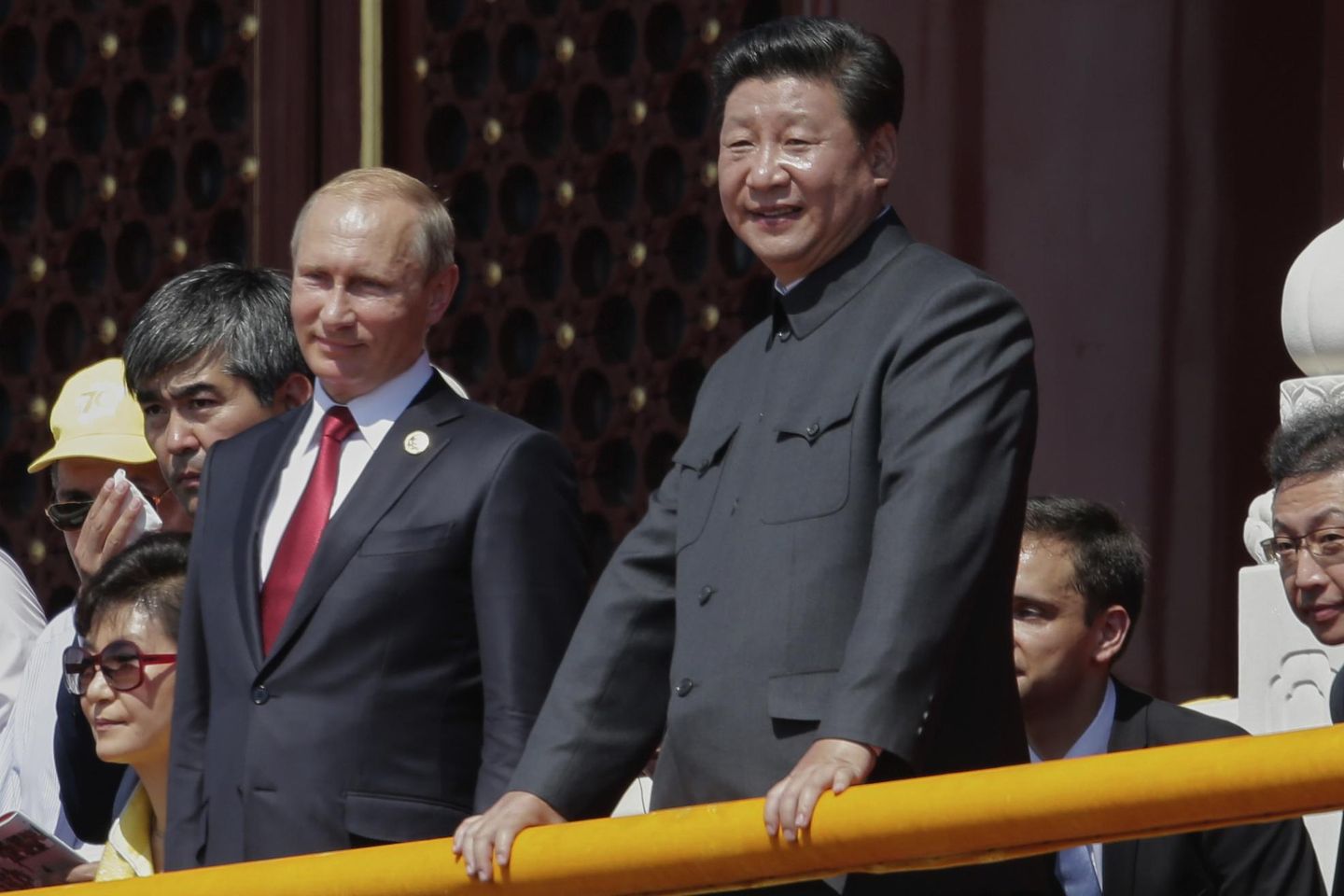
NEWS AND ANALYSIS:
Documents obtained by a European hacker group reveal that China is working with Moscow to develop a Russian-origin automated command-and-control system for landing operations such as a future invasion of Taiwan.
The hacker organization BlackMoon obtained internal Russian and Chinese government documents in July, revealing the joint Russian-Chinese project called “Sword 208.” The documents reveal work on the automated communications system for controlling airborne units for China’s People’s Liberation Army.
The main goal of the project is to prepare PLA paratroopers for a future attack on Taiwan.
One document is an official letter on behalf of a “V. Zhurov,” director of the state-run exporter Rosoboronexport’s department of defense and space technologies, to a “V. Odrinskky,” acting director of the Research Institute of Communication and Control Systems, a military company.
The letter discusses plans for negotiations with Chinese officials by secure video conference on the project. Chinese officials involved in the talks included representatives of the Nanjing Institute of Electronics and the Chinese Defense Ministry.
A second document posted on X is a letter from Ge Xin, senior adviser to the director general of the state-run defense electronics company China Electronics Technology Group Corp. Ltd. to V. Zhurov.
CETC is listed by the Pentagon as a Chinese military company and was blacklisted by the Commerce Department on national security grounds.
The second letter from CETC dated Oct. 5, 2021, discusses preparations for the project.
The latest documents were posted Tuesday and are part of a series of internal document disclosures made public by BlackMoon’s X account.
The European investigative journalism outlet The Insider reported last week that it had confirmed the authenticity of the documents and uncovered additional details of the military cooperation.
The documents, sent from Russia to Beijing, show China has purchased materials and cooperation for the command-and-control system for assault operations for 4.3 million euros, or $5.1 million.
The document shipments took place beginning 2020 until most recently 2024.
The system is said to provide the PLA with the ability to manage and coordinate airborne operations through secure data transmission, tactical and operational information sharing, mission planning and target designation.
The documents highlight an unexpected aspect of PLA military planning for a Taiwan invasion — an airborne assault.
Defense officials have said the most likely invasion scenario by the PLA would be a seaborne assault using military forces delivered by civilian ferries and commercial roll-on, roll-off freighters for equipment.
If an airborne assault is added to PLA operations, it could further complicate efforts by Taiwan and its allies to defend the island.
A defense official told The Washington Times that the PLA is training for an extraordinarily difficult mission: to coordinate across all military domains against Taiwan and the United States and other regional allies “to execute what’s arguably the hardest conventional military operation known to man — an opposed amphibious landing across a body of water.”
The PLA is getting close to having the capabilities for such an invasion, the official said.
Efforts to prepare for an invasion were shown off by the PLA recently in photos revealing exercises with special landing barges that can move troops and tanks from the sea to the land.
The hacked documents described the airborne assault system as a hardware and software packet for the Russian KShM-E command-and-staff vehicle for airborne deployment, and hardware and software for the KAS-E integrated communications system, also for airborne deployment.
Other documents provide details of a standard automated module for field command posts, and a unified hardware and software package for the BMD-E airborne combat vehicle. A man-portable hardware-software package was also provided.
In addition to the BlackMoon documents, The Insider reported obtaining additional documents that discuss training for Chinese specialists.
The training was to include 152 hours of lectures for 60 PLA military personnel, along with 130 hours of group sessions, and 150 hours of practical training.
The curriculum was to include the study of Russian R-187BE and R-188E (UKUS-E) radio stations, as well as the InmarSat-BGAN Explorer 727 system.
One document on the program states that it is a “Training program for PLA airborne troops in operating the equipment of the basic communications and tactical-level command automation system, and in employing it during combat missions.”
The documents reveal that while Russia has a limited ability to sell hardware due to the strain of the war in Ukraine, its military technology and expertise are being sought by China for its Taiwan invasion preparations.
Taiwan, China respond to Trump saying Xi won’t order invasion
The Taiwan Foreign Ministry said this week in response to President Trump’s comment that China will not invade the island democracy while he is president that the island nation must rely on its own efforts for security.
Asked about Mr. Trump’s comments last week that Chinese President Xi Jinping told him that a Taiwan invasion would not take place while Mr. Trump is president.
Foreign Ministry spokesman Hsiao Kuang-wei said the Taipei government closely monitors interactions between senior U.S. and Chinese officials.
“Taiwan’s security must be achieved through its own efforts, so our country has been dedicating itself to raising its self-defense capabilities and resilience. Our country will keep working hard to do this,” Mr. Hsiao told reporters Tuesday.
China has been aggressively ramping up military operations around Taiwan for the past several years. The operations include daily flights by large numbers of warplanes, and several warships.
Adm. Sam Paparo, commander of the U.S. Indo-Pacific Command, has said the operations are not exercises but practice for a future invasion.
Despite promises to resolve differences with Taiwan peacefully, China has not renounced the use of force to take control over what it views as a breakaway Chinese province.
Mr. Xi has ordered Chinese military forces to be ready for action against Taiwan by 2027.
Taiwan is a key unofficial U.S. ally and economic partner that produces most of the world’s advanced microchips, including those used for cutting-edge artificial intelligence.
Mr. Trump told Fox News on Friday as he traveled to Alaska for the summit with Russian President Vladimir Putin, that Mr. Putin’s designs on Ukraine are similar to those of Mr. Xi on Taiwan.
“You have a very similar thing with President Xi of China and Taiwan, but I don’t believe there’s any way it’s going to happen,” Mr. Trump said. “As long as I’m here, we’ll see. He told me, ‘I will never do it as long as you’re president.’”
In Beijing, Chinese Foreign Ministry spokeswoman Mao Ning did not respond directly when asked about Mr. Trump’s comments.
China’s position on Taiwan is that the island is “an inalienable part of China’s territory,” she said.“The Taiwan question is purely China’s internal affair,” Ms. Mao said. “We are willing to strive for the prospect of peaceful reunification with utmost sincerity and effort, but we will never ever allow anyone or any force to split Taiwan from China in any way.”
First flight test of Air Force hypersonic cruise missile set
Air Force’s new Hypersonic Attack Cruise Missile is slated for its first flight test this fall, according to Air Force budget documents.
Initial flight test of the HACM prototype will take place in fiscal 2026, which begins Sept. 1, the service’s budget request document said, noting the program includes subsystem qualification testing and complete integration, assembly, test, and checkout.
“Efforts will also include initial flight testing of HACM prototypes and other risk data,” one document states.
The HACM will be launched from B-52 and the forthcoming B-21 bombers and will use scramjet technology for flying at multiple altitudes and with a maneuvering flight pattern. It will also be fired from F-15 and F-18 jets.
“It will carry a conventional warhead, allowing commanders to effect responsive strikes against high value, heavily defended targets with precision, emphasizing survivability and maneuverability,” another Air Force document states.
Because of its speed — more than five times the speed of sound — HACM will hit enemy targets “within minutes to a few hours” based on launch location and target distance.
“The speed and maneuverability of the missile are designed to overcome sophisticated enemy air and missile defenses, and it will be launched at standoff ranges from both penetrating and nonpenetrating bomber aircraft,” the Air Force said.
The weapon is needed to counter China, the Air Force said in a third budget document.
“The [Air Force] department is ready to deter and prevail against today’s threats, however, to maintain our advantage and improve our operational posture we must continue immediate and significant capability modernization to keep pace with the growing military capabilities of China,” the document said.
Funding for HACM will increase to $802 million in 2026, a sharp increase from $354 million spent in 2025.
The Air Force is building a second hypersonic missile, a glider launched atop an Army long-range ATACMs missile, called the Air-launched Rapid Response Weapon, that was unfunded two years ago but will receive $387 million in 2026.















